Circle too small, horse falling off the rail, rider cutting corner, horse weaving down the centerline … Do these judge’s comments seem familiar? They do to many riders; and like many riders I’ve had them on my own score sheet once or twice, in the past. At first I thought I just needed to spend some time working on my geometry in a proper dressage arena with letters and markers, and perhaps a traffic cone or two. While it was valiant of me to take responsibility for the problem, the real root of the cause lay not in my inability to form a simple circle, but with a glaring hole in my horse’s basic training. I’ve grouped the above judge’s comments together because they are all symptoms of the same cause. This is an affliction an old friend of mine used to call a “gravity storm,” which in quasi-technical terms is actually a lapse in balance known as falling in.
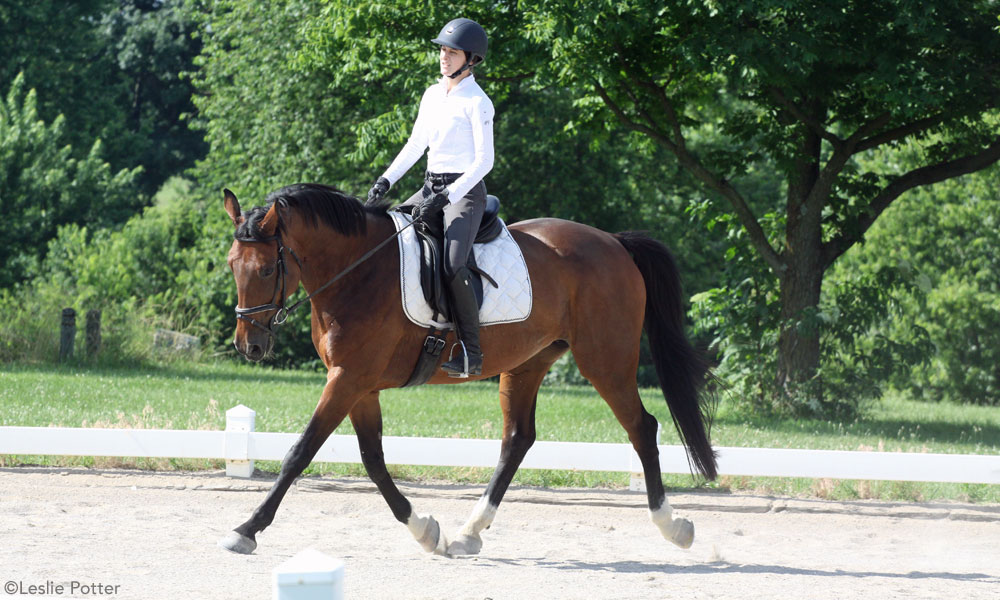
To find out if this is the case, ride a circle, then momentarily loosen your reins (or even hold them in the proper position) and see what happens. If your horse holds himself up and continues to track around the pattern, you’re on the right path. If he falls in, you’ve got to go back to the drawing board and address the issue of balance. If you don’t, you and your horse will have difficulty advancing because balance affects just about everything you do, including collection, riding patterns, transitions and even jumping fences, particularly intricate combinations.
How do you fix these gravity storms? First of all, as we’ve just discovered, you have to understand that you can’t do the job for your horse. So how have you been enabling your horse’s balance problems? Could it be any of the following?
Horse and Rider Error: I Don’t Mind if You Don’t
Adaptation is a common theme with every horse and rider who’ve been exclusive partners for a long time, and you might not realize that you’ve both grown accustomed to each other’s bad habits. You’ve helped balance your horse on turns, circles and patterns for a long time because … well, that’s just theway you’ve always done it. Because of this, your horse may not respond to correct aids, which may prove difficult when you’re trying to learn a new way.
This homespun approach on a correctly trained horse may not work very well. Therefore, it’s a good idea to ride a well-schooled horse whenever you can. The experienced horse won’t support your mistake. Once you’ve learned the correct way, you’ll be able to understand where your own horse’s weak points are and stop covering up for him.
Rider Error: Modified Rein Position
Remember when you were first learning to ride, and your instructor held your hands in the correct position? Like my instructor, she may have even suggested that you imagine holding two ice cream cones. Look at how you’re holding the reins now. You may be surprised to find that you’ve developed a habit of holding your reins in a cockeyed fashion. The inside rein may be pushed against the horse’s neck in an attempt to “neck rein” him out onto the circle. Or worse, you’ve started crossing your hand over his neck to “super neck rein” him out to the circle. Or maybe you’ve learned to drag the horse out with your outside rein, and now you’ve got one hand that is permanently parked a foot away from his neck.
Put your hands back in the right position: each one a couple of inches away from the horses neck—equally. If you’re on a circle, flex the horse’s head to the inside with a slight squeeze of the inside rein.
Note: It is true that you can open the outside rein to encourage the horse back out, but use this method sparingly as it can become a crutch for the horse to lean on later. Make sure you do it with a supporting inside leg (see “Inside Leg to Outside Rein” below). If you aren’t sure, have a knowledgeable friend or instructor show you how.
Rider Error: Skipping the Fundamental Aid—Inside Leg to Outside Rein
The incorrect or lack of use of the inside leg to outside hand aid is a common issue for many riders. This aid is extremely important for many reasons. It helps balance or re-balance a horse, and it is used during lateral work and while straightening the horse. It’s examined in the early stages of dressage tests, when the rider is asked to give the inside rein on the circle. The judge wants to see that the horse can maintain his balance without his rider holding him there with the inside rein; he remains on the circle because of the rider’s correct use of the inside leg to outside rein aid.
It doesn’t really matter which comes first, the leg aid or the rein aid, but suffice to say that one is always followed immediately behind the other: a light squeeze of the inside leg and then a slight squeeze on the outside rein (or vice versa). The aid lasts momentarily (enough time to say “elephant”) and is repeated if needed. Riders go wrong when they forget to use one or the other. If you use only your leg, the horse will think you want him to go forward and respond with speed; if you only use your rein, your horse will think you want to slow down and will respond in kind. The two work together to use the horse’s energy, generated by your leg and directed by your hand, to balance the horse. In simpler terms, the outside rein prevents the horse from falling out, and the inside leg prevents him from falling in. The two together balance the horse.
You have to admit that thumping kicks, snatching reins and awkward hand positions have no place in good equitation. Crude aids can never be acceptable riding methods, no matter what your horse is doing. Promise yourself to ride correctly, no matter what happens. And here’s a tip-off: You know something has gone wrong if you have to ride incorrectly or modify your position to correct your horse.
Now that you’ve signed the contract not to prop your horse up anymore, be warned: Without your help, your horse is going to have to find his own way in the world and figure out how to balance himself and to strengthen unused muscles. It’s going to look a whole lot worse before it looks better.
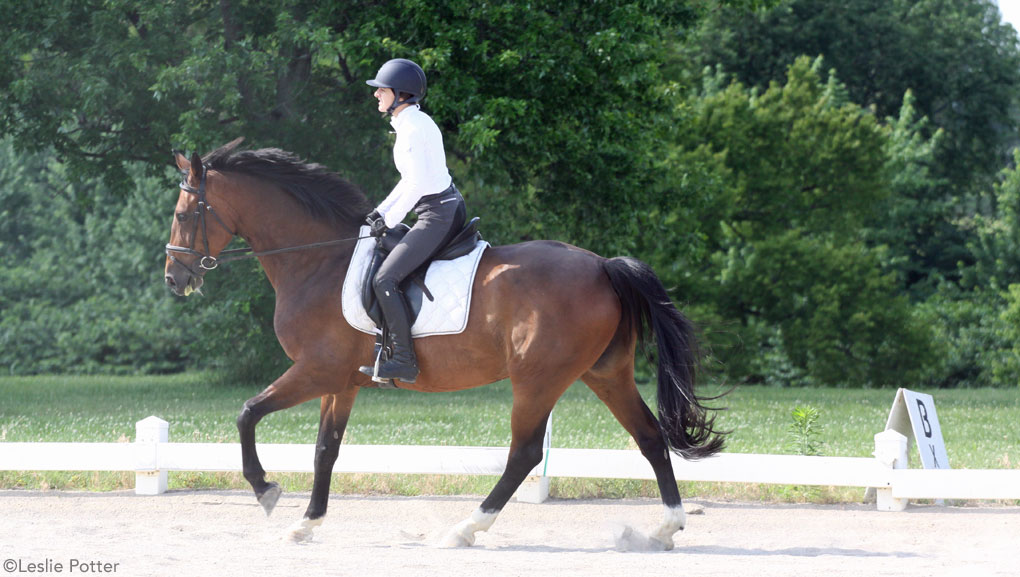
Regaining a Balanced Ride
Step One: Begin by asking your horse to trot on a 20-meter circle. Make sure your bending aids are correct (inside leg just at the girth, outside leg just behind the girth, shoulders turned toward the inside of the circle, slight flexion with the inside rein and a steady contact on the outside rein) and maintain a steady tempo (speed). Keep your eyes up and try to ride a correct circle that starts and finishes at the same point. Set cones out if you need help in positioning your circle.
As you feel your horse duck off the line, don’t change your aids; instead, let your horse fall in, even if he spirals into a very small circle. If your horse is accustomed to you holding him up, he won’t try to balance himself. He’ll wait for you to come to the rescue. Don’t do it. Instead, let him continue to fall in. Now begin asking him to move out on the circle by using your inside leg to outside rein. Ask softly and wait for him to respond. Tiny circles are hard work, and very soon he’ll listen to your aids and take himself out on the circle. Whatever you do, don’t change your position or way of aiding, and try to keep looking up and thinking about making a proper circle. Your eyes will help with your own balance, which in turn helps encourage your horse to move out on the proper line.
Step Two: When you feel your horse begin to make his circle larger, pat his neck with your inside hand. You should be able to ride a circle with little or no inside rein at all, which will prove your horse is in balance.
Part of the Process
Quick Step: In extreme circumstances you may find that your horse loses his balance so badly that he speeds up as he circles. You can impose your tempo on the horse by accentuating your posting trot. Land a little bit deeper in the saddle, and gently half-halt until he brings his haunches underneath himself and slows down. Your horse may also discover that it is very difficult to rush on a circle and will slow down of his own accord.
Baby Steps: Falling in is a normal development in a young horse. As he’s learning to balance himself and his rider at the same time, he’ll struggle to stay on a steady line. The key is to let him learn to hold himself up and not give him a “nose wheel” (i.e. your reins) to prop himself up on. It takes patience, skill and the ability to look the other way when a young horse is learning to balance. Think of when a young child learns to color a picture. As coloring outside the lines is part of the child’s learning curve so is a horse’s awkward attempts to balance his rider.
Moving On: Once your horse is balancing himself on the circle, begin to ride straight ahead. You may find that your horse isn’t able to maintain that same balance on the straightaways and falls in once more. As he begins to fall in, make a small 15- to 10-meter circle and then gently apply your inside leg to outside rein aid. This may take a few revolutions but keep up with it. Once you feel that your horse is balancing on his own, apply a stronger outside rein and move back on the straight line. Repeat as you feel your horse falling in. This exercise has the added value of strengthening the inside hind leg, which will help the horse increase his ability to balance in more difficult shapes and patterns, such as serpentines. Once your horse gets strong enough he will be able to handle straight lines and bending lines, and be able to move smoothly from one to the other. Keep the faith with these exercises. Your horse’s problems with balance have probably been an issue for a while, and it will take a few sessions until he’s able to sort himself out.
The Feeling of Balance
Think back to when you were a kid and did the old “look ma no hands” on your bicycle. You knew it was safe to let go when your bike felt perfectly balanced. Your horse will feel similar. An unbalanced horse will feel as though he’s tilting in or slanted toward the circle. You’ll also feel as though he’s leaning against your inside leg, and his ribcage will feel very heavy and unyielding. He’ll also feel heavy on one rein or the other.
You can even check for balance and copy the “look ma no hands” by giving one or both of the reins forward in a slight downward stretch. If your horse stays in the same tempo and remains on the same line, he’s in balance.
This article first appeared in the December 2004 issue of Horse Illustrated. Click Here to subscribe.

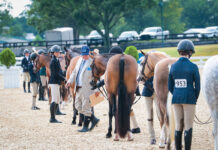
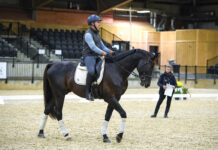
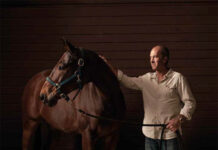

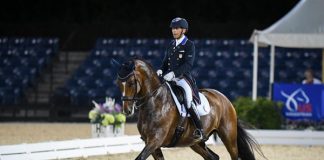

This bit of advice has helped me a great deal with my horses habbit of falling in. Never did it strike me as a balance issue untill after i read this article! I realized my horse was leaning far too much on my reins and have since corrected the promlem:)
I find that when my horses fall in, it’s because I am – I tend to lean into the circle, so my horse does too. I’m working on keeping my back straight up, and it helps quite a bit.
This was really helpful! I have a 4 year old that really needed this. Thank you!
Thanks this was really helpful!
Thanks, I am working toward showing and can’t wait.
Since I am disabled and co-leasing, first show I plan to take horse so that he and I will get use to the enviroment change from stable to comptetion.
I am not on your level and my neurologist is pleased with status. My trainer and I have worked for 17 months just on walk and posting trot. She plans to refine my seat and start adding canter.
Thanks for the article.
Wow. Thanks SO MUCH for this article! I’ve had so many balance problems in the past with my horse, I can’t wait to try these tips out!
Wow, this is a great addition.
I read the news about this horrible accident.
I wish Ms. Courtney King fast recovery.
By coincidence my wife Milena had a similar accident on 14 of February this year. Her horse stumbled two steps after jumping the fence, tipped over left side and fell. She stayed in the tack and she hit her head on the ground.
Thanks GOD she was wearing a helmet and this probably safe her life.
She was in coma for 3 days in the intensive care and another 10 days in hospital. She is now recovering at home.
The reason I’m writing is first of all to wish well for Ms. King and her full recovery.
The other reason is to raise the question how safe the helmets are. The helmet of my wife was GPA “SPEEDAIR-UNI” model.
I was observing carefully it after the accident. My finding is that the inner side is a bit hard and there is no enough absorption room for such impacts.
Shall be grateful if some of you write me back their comments and proposals in this respect.
Long article that I will have to come back and reread, but now I know what I have been doing is not correct.
I really loved this article.
Excellent article! I’ll reread this time and time again I’m sure. I have a Friesian that’s new to dressage, this article was just what I needed to assist him in learning how to have correct balance. Thanks Sharon!
Very interesting article, but I will have to reread it.
It’s amazing how our small mistakes make such a big difference in our horses’ movement. This goes to show how much patience horseback riding takes for both horse and rider.
This will be really helpful when working with green horses who bend the opposite way you want them to! Loved this article! 😀
So glad i found this article! Ive been having this falling in problem with my TB especially when he tries to cut corners to get back to the feed shed. I tried the inside leg to outside rein today and it worked perfectly! Its so simple but i couldnt work out how to get him back out onto the circle without steering his head crudely back out, bending him in the opposite direction he should be bent. Just that slight squeeze with the outside rein pushed him back out to the circle while maintaining the inside bend. Thanks so muc, will be bookmarking this article! 🙂